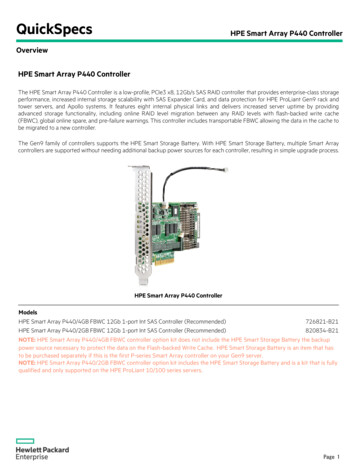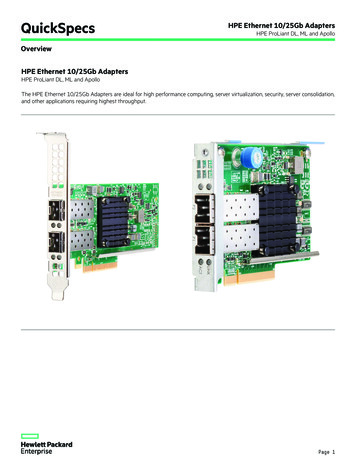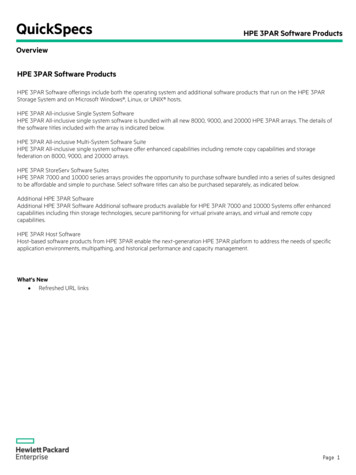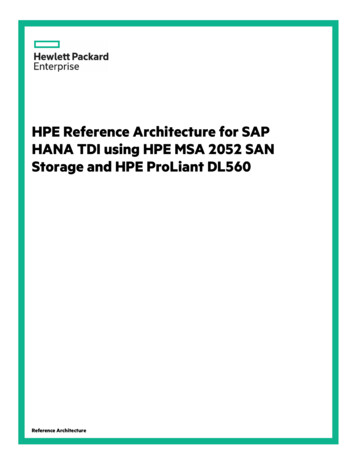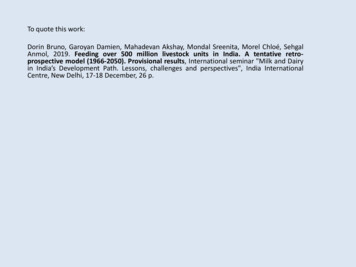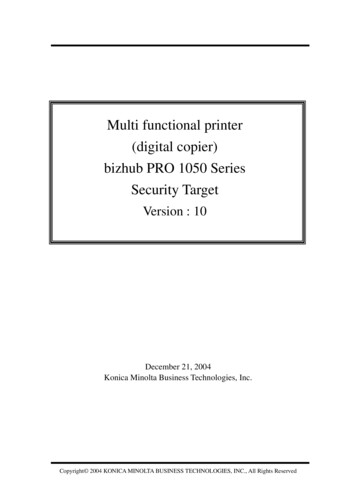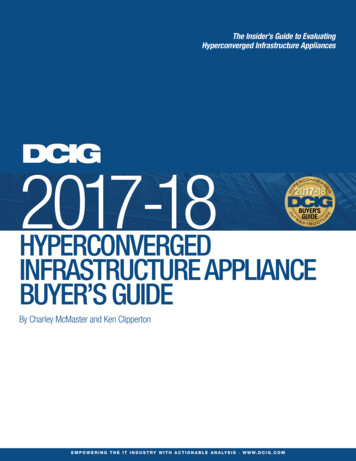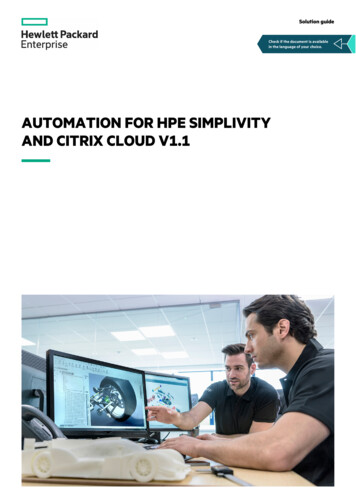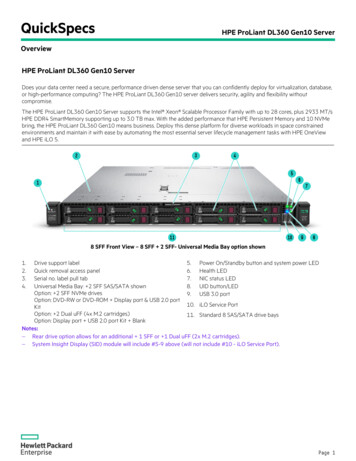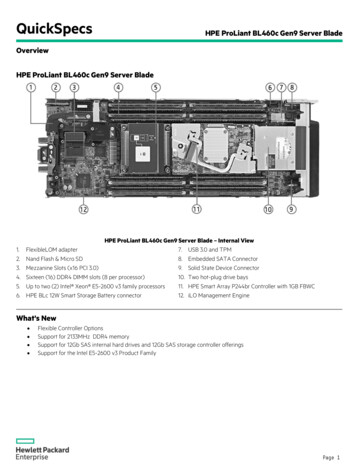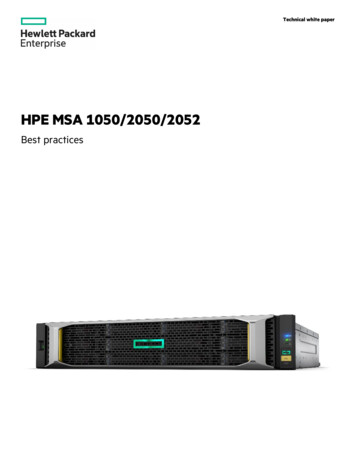
Transcription
Technical white paperHPE MSA 1050/2050/2052Best practices
Technical white paperContentsExecutive summary . 4Intended audience .4Prerequisites .4Related documentation .4Introduction .5Terminology. 6General best practices . 8Become familiar with the array by reading the manuals .8Stay current on firmware .8Review settings in the Welcome panel of the SMU.8Use tested and supported configurations .9Understand what a host is from the array perspective. 9Rename hosts to a user-friendly name.9Best practice for monitoring array health . 10Configure email and SNMP notifications . 10Set the notification level for email and SNMP . 12Sign up for proactive product advisory notifications . 12Best practices for provisioning storage on MSA 1050/2050/2052 arrays . 13Thin Provisioning. 13Pool balancing . 14Wide striping . 15Using MSA 2052 embedded SSDs . 16Automated Tiering . 17Volume Tier Affinity . 20Best practices when choosing drives for MSA 1050/2050/2052 storage . 22Drive types.22SSD endurance .23Using the I/O Workload functionality to determine SSD capacity . 23Best practices to improve availability . 25Volume mapping. 25Redundant paths . 27Snapshots . 32Dual power supplies . 32Reverse cabling of disk enclosures . 32Create disk groups across disk enclosures . 33Drive replacement. 34Implement Remote Snap replication .34
Technical white paperBest practices to enhance performance. 34Cache settings . 34Host port utilization for maximum performance . 36Other methods to enhance array performance . 36Best practices for SSDs . 38Use SSDs for randomly accessed data. 38SSD and performance. 38SSD read cache.39SSD wear gauge . 39Full disk encryption . 40Full disk encryption on the MSA 2050/2052 . 40Best practices for firmware updates . 40General MSA 1050/2050/2052 device firmware updates . 40MSA 1050/2050/2052 array controller or I/O module firmware updates . 41MSA 1050/2050/2052 disk drive firmware updates . 41Miscellaneous best practices . 41Boot from storage considerations . 418 Gb/16 Gb switches and small form-factor pluggable transceivers . 41MSA 1050/2050/2052 iSCSI considerations . 42Hot adding disk enclosures . 43User management with the MSA . 50Summary . 52
Technical white paperPage 4Executive summaryThis white paper highlights best practices for optimizing and deploying HPE MSA 1050/2050/2052 arrays and should be used together withother HPE MSA manuals. The MSA 1050/2050/2052 array is the fifth-generation MSA storage area network (SAN). MSA technical userdocuments are available from the HPE MSA Storage webpage. This paper is also designed to convey best practices in the deployment of theMSA 1050/2050/2052 array.NoteImages shown in this document reflect current software functionality as of the latest firmware available at the time of publication. Features andfunctionality might vary with different storage system firmware levels.Intended audienceThis white paper is intended for MSA 1050/2050/2052 administrators with previous SAN knowledge. It offers best practices that can contributeto an MSA best customer experience.PrerequisitesPrerequisites for using this product include knowledge of: Networking Storage system configuration SAN management Connectivity methods such as direct attached storage (DAS), Fibre Channel, and serial attached SCSI (SAS) iSCSI and Ethernet protocolsRelated documentationIn addition to this guide, other documents or materials for this product include: HPE MSA System Racking Instructions HPE MSA 1050 User Guide HPE MSA 2050 User Guide HPE MSA 1050/2050 Storage Management Utility (SMU) Reference Guide HPE MSA 1050/2050 CLI Reference Guide HPE MSA 1050 Quick Start Instructions HPE MSA 2050/2052 Quick Start Instructions HPE MSA 1050 Cable Configuration Guide HPE MSA 2050 Cable Configuration GuideYou can find HPE MSA 1050/2050/2052 documents from the Hewlett Packard Enterprise Information Library for the HPE MSA 1050 andHPE MSA 2050/2052.
Technical white paperPage 5IntroductionThe MSA models referenced in this paper include the MSA 1050, MSA 2050, and MSA 2052.MSA 1050The MSA 1050 is designed for entry-level markets. It features 8 Gb Fibre Channel, 6 Gb/12 Gb SAS, and 1 GbE and 10 GbE iSCSI protocols. TheMSA 1050 also features: 6 GB cache per controller (4 GB read/write plus 2 GB system memory) Support for small form factor (SFF) and large form factor (LFF) solid-state drives (SSDs) Two host ports per controller 4 Gb/8 Gb Fibre Channel connectivity 1 GbE/10 GbE iSCSI connectivity 6 Gb/12 Gb SAS connectivity Support for MSA fan-out SAS cables Support for up to four disk enclosures including the array enclosure Support for up to 96 SFF drives and 48 LFF drives Support for Performance Tiering software 1 Automated Tiering Thin Provisioning Support for read cache Wide striping, which allows more hard drives behind a single volume to improve performance (for example, more than 16 drives per volume) Support for replication snapshot history and queueing for Remote Snap 2 Remote Snap for both Fibre Channel and iSCSI2MSA 2050The MSA 2050 is a high-performance storage system designed for Hewlett Packard Enterprise (HPE) customers who want 8 Gb or 16 Gb FibreChannel, 6 Gb or 12 Gb SAS, and 1 GbE or 10 GbE iSCSI connectivity with four host ports per controller. The MSA 2050 is the industry’s fastestentry-level array. It provides excellent value for customers who need performance balanced with price to support initiatives such as consolidationand virtualization.The MSA 2050 delivers this performance by offering: Twice the I/O performance compared to the previous generation 8 GB cache per controller (4 GB read/write plus 4 GB system memory) Support for SFF and LFF SSDs Four host ports per controller 4 Gb/8 Gb/16 Gb Fibre Channel connectivity 1 GbE/10 GbE iSCSI connectivity 6 Gb/12 Gb SAS connectivity Support for both Fibre Channel and iSCSI in a single controller12A license is required for the Performance Tier for mixed SSD and hard disk drive (HDD) systems. For a system with only SSDs, a Performance Tier license is not required.Remote Snap software requires a license.
Technical white paperPage 6 Support for up to eight disk enclosures including the array enclosure Support for up to 192 SFF drives and 96 LFF drives Support for read cache Thin Provisioning Automated Tiering Support for Performance Tiering 3 Wide striping, which allows more hard drives behind a single volume for improved performance (for example, more than 16 drives per volume) Support for replication snapshot history and queueing for Remote Snap 4 Remote Snap for both Fibre Channel and iSCSI4 Volume Copy across pools Support for full disk encryption (FDE) using self-encrypting drives (SEDs) 5MSA 2052The MSA 2052 SAN offers an entry-level platform with built-in hybrid flash for application acceleration and high performance. It is ideal forperformance-hungry applications and includes 1.6 TB of SSD capacity.An MSA 2052 storage system supports all the features of the MSA 2050, plus 1.6 TB of SSD capacity, standard. The MSA Advanced DataServices (ADS) Suite is included as a standard feature on the MSA 2052 at no extra charge. The MSA ADS Suite includes the followingfunctionality: Performance Tiering and Archive Tiering licenses A 512-snapshot license Remote Snap licenseNoteThe ADS Suite license key ships standard with the MSA 2052 array and must be redeemed and installed to enable the services.The MSA 1050/2050 storage systems ship standard with a license for 64 snapshots and Volume Copy for increased data protection. There is anoptional license for 512 snapshots.The MSA 1050/2050/2052 can replicate data between MSA 1050/2050/2052 arrays using Fibre Channel or iSCSI. The user can also replicatefrom an MSA 1050/2050/2052 to an MSA 1040/2040/2042 array using virtual volumes only if the MSA 1040/2040/2042 has GL200 ornewer firmware. The optional Remote Snap feature is needed for the replication.TerminologyThe following terms are used throughout this white paper. These definitions are key to understanding MSA arrays. Virtual storage: Data is virtualized not only across a single disk group, but also across multiple disk groups with different performancecapabilities and use cases. Page: A page is an individual block of data residing on a physical disk. A page is the smallest unit of data that can be allocated, deallocated, ormoved between virtual disk groups in a tier or between tiers. For virtual storage, the page size is 4 MB.A license is required for the Performance Tier for mixed SSD and hard disk drive (HDD) systems. For a system with only SSDs, a Performance Tier license is not required.Remote Snap software requires a license.5SEDs are supported only in the MSA 2050.34
Technical white paperPage 7 Disk group: A disk group is a collection of disks in a given RAID level. Storage pools: Storage pools are composed of one or more virtual disk groups. A volume’s data on a logical unit number can span all diskdrives in a pool. When capacity is added to a system, users benefit from the performance of all spindles in that pool. When leveraging storagepools, an MSA 1050/2050/2052 array supports large, flexible volumes with sizes up to 128 TiB and facilitates seamless capacity expansion.As volumes are expanded, data automatically reflows to balance capacity utilization on all drives. Logical unit number (LUN): MSA 1050/2050/2052 arrays support 512 volumes and up to 512 snapshots in a system. All these volumes canbe mapped to LUNs. The maximum LUN size is 128 TiB. Thin Provisioning: Thin Provisioning software allows storage allocation of physical storage resources only when they are consumed by anapplication. Thin Provisioning also allows you to overprovision physical storage pool resources, enabling volumes to grow without having topredict storage capacity up front. Tiers: Disk tiers consist of an aggregation of one or more disk groups of similar physical disks. MSA 1050/2050/2052 arrays support threedistinct tiers:– A performance tier with SSDs– A standard SAS tier with enterprise SAS HDDs– An archive tier using midline SAS HDDsLUN-level tiering requires careful planning. You should place applications that require the best performance on disk groups that use highperformance SSDs. You can place applications with lower performance requirements on disk groups consisting of enterprise SAS or midlineSAS HDDs.The MSA 1050/2050/2052 Automated Tiering engine moves data between available tiers based on the access characteristics of that data.Frequently accessed data contained in pages is migrated to the highest available tier, delivering maximum I/Os to the application. Similarly,cold or infrequently accessed data is moved to lower performance tiers. Data is migrated between tiers automatically so that I/O is optimized inreal-time.Archive and standard tiers are provided at no charge on the MSA 1050 and MSA 2050 platforms. A performance tier using a fault-tolerantSSD disk group is an add-on feature that requires a license for the MSA 1050/2050. Without a Performance Tier license installed, you can stilluse SSDs as read cache with the sub-LUN tiering feature. Sub-LUN tiering from SAS midline (MDL) (archive tier) to enterprise SAS (standardtier) drives is provided at no additional charge for the MSA 1050/2050/2052 arrays. Read cache: Read cache is an extension of the controller cache. Read cache provides a lower-cost way to get performance improvements fromSSDs. Automated Tiering: Automated Tiering is a technology that enables the automatic movement of data between storage tiers based on accesstrends. In MSA 1050/2050/2052 arrays, Automated Tiering places data in a LUN that is accessed frequently in better-performing media; datathat is infrequently accessed is placed in slower media. Array enclosure: This is the array head or chassis of the MSA that includes the MSA controllers. Disk enclosure: This is the expansion shelf that is connected to the array enclosure. Storage system: This is the whole MSA system that includes the array enclosure and disk enclosures.
Technical white paperPage 8General best practicesThis section outlines some general best practices when administering an MSA storage system.Become familiar with the array by reading the manualsThe first recommended best practice is to read the corresponding guides for the MSA 1050 and MSA 2050/2052. These documents include theUser Guide, the SMU Reference Guide, and the CLI Reference Guide. The appropriate guide depends on the interface that you will use toconfigure the storage array. Always operate the array in accordance with the user manual. In particular, never exceed the environmentaloperation requirements. The MSA Remote Snap Software technical white paper is also helpful to review.Stay current on firmwareUse the latest controller, disk, and disk enclosure firmware to benefit from the continual improvements in the performance, reliability, andfunctionality of MSA 1050/2050/2052 arrays. For additional information, see the release notes and release advisories for the respective MSAproducts. You can find the latest firmware for all components in MSA arrays at https://www.hpe.com/storage/msafirmware. Additional informationis available from the HPE Support Center.Review settings in the Welcome panel of the SMUThe Welcome panel in the SMU provides options for you to quickly and easily set up the MSA system. It also guides you through the firmwareupdate and configuration process. To use guided setup, you must first access the Upgrade Firmware panel where you can review the controllermodule firmware version and perfo
This white paper highlights best practices for optimizing and deploying HPE MSA 1050/2050/2052 arrays and should be used together with other HPE MSA manuals. The MSA 1050/2050/2052 array is the fifth -generation MSA storage area network (SAN). MSA technical user documents are available from the HPE MSA Storage. webpage. This paper is also .
